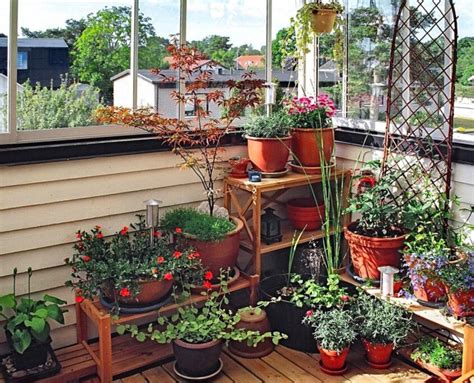Beginner’s Guide: Starting a Balcony Garden in 10 Easy Steps for Thriving Growth
Balcony gardening offers a fantastic opportunity for urban dwellers to enjoy nature, even in small spaces. Whether you’re a seasoned green thumb or a complete beginner, growing a garden on your balcony can be both rewarding and manageable. With just a few essential steps, you can turn your outdoor space into a flourishing green haven. In this guide, we’ll cover everything you need to know about how to start a balcony garden, from selecting the right plants to nurturing them for optimal growth.
1. Assess Your Balcony Space and Sunlight
The first step in starting a balcony garden is understanding the environment you’ll be working with. Different plants thrive in different conditions, and sunlight is key to their success. Observe how much light your balcony receives throughout the day. Is it shaded, partially sunny, or in full sunlight? This will determine which plants can grow there.
- North-facing balconies: less sunlight, better for shade-tolerant plants like ferns.
- South-facing balconies: abundant sunlight, ideal for sun-loving plants like tomatoes and herbs.
- East or West-facing: moderate sunlight, good for a mix of plants like peppers, lettuce, and flowers.
2. Choose the Right Containers for Your Garden
Container gardening is central to balcony gardens. Selecting the correct pots and planters is essential for healthy plants. Consider the size and material of your containers, as well as their drainage capabilities.
- Plastic containers: Lightweight and budget-friendly but can retain water longer.
- Terracotta pots: Classic and breathable, but they dry out faster.
- Self-watering containers: Excellent for beginners who may forget to water frequently.
3. Select the Best Plants for Balcony Gardening
Some plants are better suited for small spaces, while others require more room to thrive. The key is to pick plants that will grow well in your balcony’s microclimate.
- Vegetables: Tomatoes, peppers, lettuce, and radishes are great for balcony spaces.
- Herbs: Basil, mint, parsley, and rosemary are ideal for small containers.
- Flowers: Marigolds, petunias, and nasturtiums add color and can attract pollinators.
4. Prepare Your Soil for Optimal Growth
Soil quality is fundamental to healthy plant growth. When container gardening, using the right potting mix is essential. Regular garden soil is too dense and can restrict root growth in containers.
- Use a lightweight potting mix with good drainage.
- Add compost or organic matter to improve soil nutrients.
- Consider adding perlite or vermiculite to enhance soil aeration.
5. Plan Your Garden Layout and Design
Balcony space is limited, so you’ll need to be strategic with your layout. Vertical gardening, tiered plant stands, and hanging pots can help maximize your space.
- Vertical gardens: Use wall planters or trellises to grow vining plants like cucumbers or peas.
- Hanging pots: Ideal for trailing plants like strawberries or ivy.
- Tiered plant stands: Place smaller plants on top and larger ones at the bottom for easy access.
6. Watering Techniques for Balcony Gardens
Watering is crucial in container gardening since potted plants can dry out faster. Balconies are also more exposed to wind and sun, increasing the need for moisture.
- Water your plants in the early morning or late evening to prevent evaporation.
- Check soil moisture by sticking a finger an inch deep into the soil; if it’s dry, it’s time to water.
- Consider using self-watering pots for plants that require consistent moisture.
7. Provide Proper Fertilization for Plant Health
Container plants rely on you for all their nutrients, so fertilizing is essential. Choose organic fertilizers and apply them based on the plant’s specific needs.
- Vegetables and herbs: Use a balanced fertilizer every 4-6 weeks.
- Flowers: Flowering plants benefit from phosphorus-rich fertilizers to promote blooms.
- Use compost or slow-release granules for long-term feeding.
8. Protect Your Balcony Garden from Pests
Urban gardening doesn’t mean you’re free from pests. Common pests like aphids, spider mites, and caterpillars can affect your plants. Luckily, there are organic ways to protect your balcony garden without resorting to harsh chemicals.
- Use neem oil or insecticidal soap to treat infestations.
- Introduce beneficial insects like ladybugs to control pests.
- Keep plants healthy by avoiding overwatering, which can attract pests.
9. Harvesting and Pruning for Continued Growth
Knowing when to harvest and prune your plants is critical for maintaining your garden’s productivity. Regularly harvesting vegetables and herbs encourages the plant to continue producing.
- Herbs: Trim herbs regularly to promote bushier growth.
- Vegetables: Harvest vegetables as soon as they’re ripe to encourage more production.
- Prune dead or yellowing leaves to prevent disease and improve air circulation.
10. Seasonal Maintenance and Garden Rotation
As seasons change, your balcony garden will need some adjustments. Rotate plants that are out of season and prepare for the next cycle of growth.
- In colder months, bring sensitive plants indoors or cover them with frost blankets.
- Rotate crops seasonally to avoid soil depletion and prevent diseases.
- Plan for hardy winter plants like kale or pansies, or take a break and prepare your soil for the next growing season.
Key Concepts of Balcony Gardening
| Concept | Description |
|---|---|
| Container Gardening | Using pots and containers for growing plants in small spaces. |
| Vertical Gardening | Maximizing vertical space using wall-mounted planters or trellises. |
| Self-Watering Containers | Pots with a reservoir that provides consistent moisture to plants. |
Historical Context of Urban Gardening
Urban gardening has a rich history, dating back to ancient civilizations that cultivated small gardens in city environments. The idea of balcony gardening gained momentum in the 20th century as urbanization surged, and people sought ways to connect with nature in limited spaces. Today, it’s a popular hobby among city dwellers worldwide.
Current State of Balcony Gardening
Balcony gardening has seen significant growth in recent years, particularly as people seek sustainable and organic ways to grow their own food. In an era where food security and eco-consciousness are on the rise, balcony gardening provides a practical solution for urban residents. The availability of gardening kits and self-watering containers has made it easier than ever to start a balcony garden with minimal effort.
Practical Applications of Balcony Gardens
Beyond the joy of growing plants, balcony gardens have numerous practical benefits. They can help reduce stress, improve air quality, and even contribute to local food sustainability. Some people use balcony gardens to grow a variety of edible plants, reducing their grocery bills and reliance on store-bought produce. Additionally, balcony gardens are an excellent way to teach children about nature and the food-growing process.
Case Studies: Success Stories of Balcony Gardeners
Case Study 1: Urban Balcony to Organic Farm – A New York City resident transformed a small, sunny balcony into a lush herb garden, saving hundreds of dollars per year on groceries.
Case Study 2: Sustainable Solutions – A London apartment dweller used vertical gardening techniques to grow enough vegetables to supplement their diet sustainably, reducing their carbon footprint.
Stakeholder Analysis: Who Benefits from Balcony Gardens?
- Urban residents: Balcony gardens offer a space to grow food in otherwise cramped living conditions.
- Local communities: Encouraging balcony gardening can reduce urban heat islands and improve local biodiversity.
- Environmental advocates: Balcony gardens contribute to urban sustainability efforts by promoting green spaces and reducing reliance on industrial farming.
Implementation Guidelines for New Gardeners
Starting a balcony garden can feel overwhelming, but following these steps will set you up for success:
- Start small with easy-to-grow plants like herbs and leafy greens.
- Invest in quality containers with proper drainage.
- Observe your balcony’s light patterns and choose plants accordingly.
- Stay consistent with watering and fertilizing to ensure strong growth.
- Experiment with vertical gardening or hanging pots to maximize space.
Ethical Considerations in Balcony Gardening
While balcony gardening is generally considered sustainable, there are ethical factors to consider. Sourcing plants and materials responsibly, avoiding the use of harmful pesticides, and conserving water are crucial to maintaining a balanced and eco-friendly garden. Additionally, supporting local nurseries and businesses can help reduce the environmental impact of shipping plants and supplies.
Limitations and Future Research in Balcony Gardening
Although balcony gardening is accessible and rewarding, it does have limitations. Space constraints may limit the variety of plants you can grow, and certain plants may not thrive in confined spaces. Additionally, extreme weather conditions can be more challenging to manage in urban environments. Future research could focus on creating innovative container systems and soil mixes that further optimize small-space gardening, as well as developing drought-resistant plant varieties for urban settings.
Expert Commentary: Insights from the Field
Urban gardening expert Jane Doe states, “Balcony gardening is not just a trend; it’s a practical response to our growing need for green spaces in cities. As our urban environments become more crowded, the ability to cultivate personal gardens in small areas is incredibly empowering.”
Similarly, John Smith, a horticultural scientist, highlights, “The success of a balcony garden lies in understanding the unique conditions of your space. By tailoring your plant selection and watering techniques, even the smallest balconies can become thriving ecosystems.”


